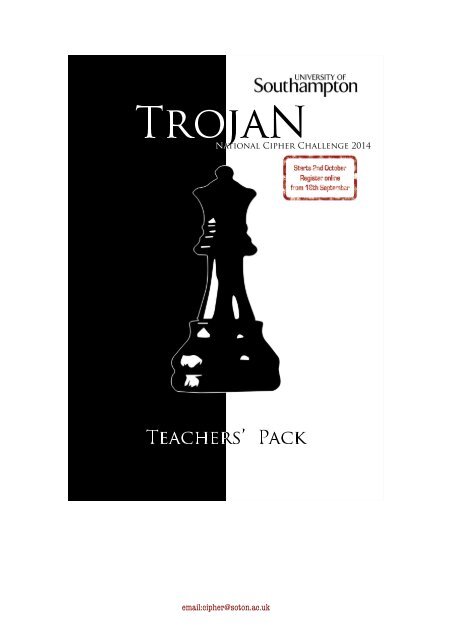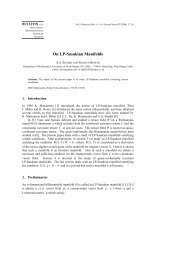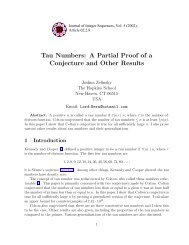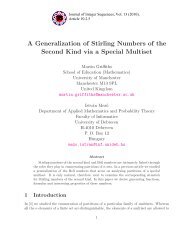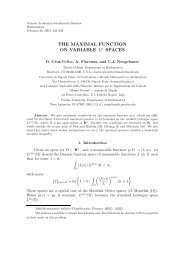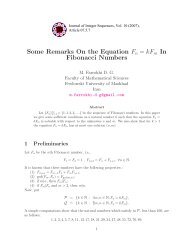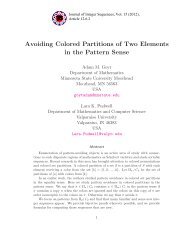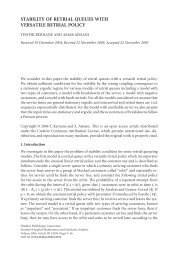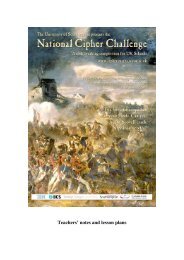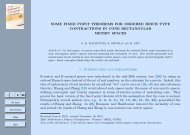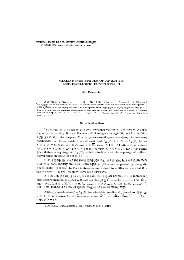Teachers' pack - National Cipher Challenge - University of ...
Teachers' pack - National Cipher Challenge - University of ...
Teachers' pack - National Cipher Challenge - University of ...
You also want an ePaper? Increase the reach of your titles
YUMPU automatically turns print PDFs into web optimized ePapers that Google loves.
email:cipher@soton.ac.uk
About the <strong>Challenge</strong>Welcome to the <strong>National</strong> <strong>Cipher</strong> <strong>Challenge</strong>, a nationwide, online codebreakingcompetition, which will run from October 2 nd 2014 to January 9 th 2015. We will openfor online registration on September 18th.The competition is a great extension activity (or a fantastic maths club project) thatcan be tackled by students in teams or on their own. There is no charge to register ortake part, and all you need to get involved is a reasonably modern web browser.This year competitors will be challenged to tackle an international gang <strong>of</strong> cyberterrorists, and the story will unfold in a series <strong>of</strong> short encrypted messages for theparticipants to crack, using all their skill and cunning. They will work with Harry todecipher these documents in order to untangle the truth and break up the hackercollective.You can download lesson plans and notes on codebreaking from the Black Chamberon the competition website. This is the competition library and, alongside thechallenges themselves, it provides a range <strong>of</strong> supporting materials that provide a goodintroduction to the skills needed by a successful code-breaker.Entrants can take part alone or in teams <strong>of</strong> any size. There are two top prizes, onesponsored by Winton Capital Management for the best entry by a team, and one,sponsored by GCHQ, for the best individual entry. To take part you will need toregister on the website, and your account also gives you access to the forum whereyou can discuss a whole range <strong>of</strong> things connected to the competition, and quite a fewthat are totally unrelated.Everyone involved in the challenge can have their own account to allow them accessto the forum, but by default only the team captain can post entries for a team withmultiple members. If you want to allow other members <strong>of</strong> the team to edit and submitentries then the team captain can use our Team Builder to invite others to join. Detailsare given below.Competition ScheduleRegistration will open online on 18 th September 2014 and the first challenge will bepublished at 3.15pm on October 9 th . <strong>Challenge</strong>s will be set periodically on the websitewww.cipher.maths.soton.ac.uk in the <strong>Challenge</strong>s section, following this schedule:<strong>Challenge</strong>Publication Solution deadlinedate 15:15 on 23:59 on1 02/10/2014 08/10/20142 09/10/2014 15/10/20143 16/10/2014 22/10/20144 23/10/2014 05/11/20145 6/11/2014 19/11/20146 20/11/2014 03/12/20147 04/12/2014 17/12/20148 18/12/2014 09/01/20152 email:cipher@soton.ac.uk
Points are awarded for speed and accuracy (with accuracy more important) but you donot have to rush to download the first challenges immediately as you have a day ortwo in which you can still get top marks. In later challenges speed will becomeimportant, and the full schedule <strong>of</strong> marks will be published so you can see howquickly you need to get started in each round.The first two challenges should be thought <strong>of</strong> as a “warm-up” exercise and will notcount in the final leader board rankings or for the award <strong>of</strong> main prizes, however it isstill worth tackling rounds one and two as they give excellent practice and do developthe storyline. There will also be a range <strong>of</strong> smaller prizes for those challenges and youwill still be able to download certificate recording your team’s performance.We have tried to avoid as many <strong>of</strong> the various half term holidays as possible acrossthe UK, but this year it has been particularly difficult to do so and we apologise inadvance if you are still affected.RegistrationTo take part you will need to register for the competition on our registration page:http://www.cipher.maths.soton.ac.uk/registerThis will be open from September 18th, and you will need to provide the followinginformation:Username: This will be the name you use to log on to the site to post comments, andalso to submit your entries, check feedback and to print your certificate. Choosesomething memorable. You can share this info among the team, but do not let anyoneelse have it as they can use it to pose as you!Password: Again this is for logging on. Choose it carefully and keep it secret.Email address: This will be used to confirm your registration so it must be an activeaccount you can check to authorise the account. If we need to contact you this is howwe will do it so add the account cipher@soton.ac.uk to the account address book toavoid sending our emails to your junk mail bin, make sure the account is not too full,and check it regularly.Teacher contact: Give the name <strong>of</strong> a teacher we can write to if we need to checkanything. You should get their permission first! We don't usually do this unless youwin a prize. If you are home schooled give us a parent or carer's name here and writehome schooled in the school name field. You will still need to give us contact detailsin the address fields below.School name: Again we will use this on the certificates and the leader boards so spellit right, and if it is a common name (like King Edward's) add a location (KingEdward's, Southampton) to identify it.School address: If you win a prize this is how we will get it to you, so it is importantthat you get this right.Headteacher’s name: If you win a prize we like to write to your Headteacher aboutit, so please give their name here.We will also ask you to say on the registration form how you would like your nameto appear on the leader boards and on your certificates. The options are to show your3
first name, your full name or just the team name (choose “none”), and you can choosea different convention for the online leader board and the certificate.Teams and solo entriesIf you are taking part on your own you only need to register as above and this willcreate a team <strong>of</strong> 1 with you as Captain. The default team name will be your user IDbut you can change that by editing your Pr<strong>of</strong>ile. If you want to enter as a group youshould each sign up for an account and choose one member <strong>of</strong> the team as Captain.The Captain should change his or her team name to the one you all want, and can thenuse the Team Pr<strong>of</strong>ile tab to invite you all to join the team. Once you accept the inviteyou will be part <strong>of</strong> that team throughout the competition. You can do this at any timebut you cannot transfer any score that you have gained yourself to the team you join.You do not have to all be at the same school, we will use the Captain’s school andemail address for any communications with the team. The names <strong>of</strong> the members <strong>of</strong>the team will appear on the leader boards and certificates according to the individualpreferences <strong>of</strong> the team members as discussed above. Anyone in the team can post asolution to the <strong>Challenge</strong>, and since your marks can’t go down as a result there isnever any harm in this. You can also all read the feedback and download individualcertificates in the Black Chamber.The structure <strong>of</strong> the competitionYou will find the <strong>Challenge</strong>s in the <strong>Challenge</strong> book in the Black Chamber. Eachround <strong>of</strong> the competition will come in two parts, Part A and Part B. Think <strong>of</strong> them asthe “easy” and the “hard” challenges (or the “hard” and “much harder” challenges ifyou prefer). Part A challenges will consist <strong>of</strong> communications between Harry and hisagents as they try to find and destroy the hacker network. You can expect thesemessages to be fairly lightly encrypted, at least at first, although in the latter stages <strong>of</strong>the competition security will be tightened and you will find the Part A ciphers harderto crack. Part B consists <strong>of</strong> the hackers own communications. At the start <strong>of</strong> thechallenge the hackers are feeling fairly invulnerable so the encryption is not too hardto crack, but as you all put pressure on them they will start to feel threatened and willuse much higher security. You may find that learning to use a spreadsheet or even toprogramme will be <strong>of</strong> particular value in tackling the later challenges.Submitting your solutionsYou can submit solutions to either part A or part B (but not both at once!) at any timeduring a round by typing them into the book entitled “Communications” in the BlackChamber library. If you need to resubmit you can use the same form. Just paste yourentry as text in the appropriate box on the form. It doesn’t matter how you formatyour answer – with or without punctuation and spaces and whether or not you usecapital letters, however you must only type or paste in the exact text <strong>of</strong> a decrypt <strong>of</strong>the message. It is a good idea to use a simple text editor to type up your solution(rather than something like Word) as the spell checker sometimes tries to change whatyou are typing and any “mistake” in the text might be deliberate. Don’t try to correctany errors you think we have made, always type in an exact decryption <strong>of</strong> the text.Don’t try to tell us what cipher we used, or to ask us a question, or to say how yousolved the cipher in the entry form, we don’t read it and it will be marked as an errorin the solution. If you need to get hold <strong>of</strong> us you can post a message on the forum orsend us an email at cipher@soton.ac.uk.4 email:cipher@soton.ac.uk
Getting helpWe <strong>of</strong>fer online feedback on submissions during each round to help you if you makemistakes. The feedback is delayed so you will lose points if you rely on it rather thantrying to correct your own errors quickly, but it can be useful if you are on the righttrack (and speed doesn’t matter for part A challenges which are only scored foraccuracy). The feedback consists <strong>of</strong> a score for accuracy, together with a copy <strong>of</strong> yoursubmission with the first error highlighted and I published in the feedback book in thelibrary. The feedback also contains a link to your certificate for the round. At the end<strong>of</strong> each round we will publish the <strong>of</strong>ficial decrypts <strong>of</strong> part A and part B in theSolutions book, which sometimes contain hints at how to tackle the next round.Participants <strong>of</strong>ten get stuck on a <strong>Challenge</strong> but, as in real life, sometimes a goodnight's rest is all you need. Other times you might need more practical help and canturn to the website for clues, either hidden in earlier rounds <strong>of</strong> the competition, orposted (by us) as comments on the forum. We ask you not to post hints <strong>of</strong> your ownwithout checking them with us first as this will spoil the <strong>Challenge</strong> for others. Anyoneposting solutions or links to solutions on our site or elsewhere may be barred from thesite and disqualified from the competition - we do search for them and do find them!ScoringEach <strong>of</strong> the two challenges in a round (part A and part B) are scored for accuracy inthe same way. We strip out all the non-ascii characters, spaces and punctuation fromyour solution, convert it to lower case and compare that string <strong>of</strong> letters with oursolution, which we have treated the same way. The more similar they are the higherthe score you will get, and if they are identical you will score 100% for that challenge.If you spot a mistake in your answer you can submit again - we only ever take yourmost accurate answer into account and accuracy beats speed in every case, thoughspeed is also important in the part B competition. In part B we look at all yoursubmissions for the round and find those with the highest mark. We then take the firstone <strong>of</strong> those that you submitted and award you points depending on how quickly yousubmitted it, according to a schedule that is published with each challenge. There areno speed points for part A, only for part B. You can find out your scores for eachround in the feedback section <strong>of</strong> the site, and we will publish a leader board for eachround. The first two rounds are a warm-up so the points will not count for the overallleader boards but from round 3 we will publish a Championship leader board basedon your total points from then in each <strong>of</strong> the competitions.PrizesThe GCHQ prize <strong>of</strong> £1,000 will be awarded to the top individual entry this year asmeasured by performance in the part B competition. The Winton Capital Managementprize <strong>of</strong> £1,000 will be awarded to the best team entry (where teams in this case musthave more than one member). We will also award runners up prizes <strong>of</strong> £750 eachsponsored by Trinity College, Cambridge for the individual competitoin and by IBMfor the team competition.A number <strong>of</strong> other smaller prizes will be awarded throughout the competition and youwill find out about them on the blog hosted on the front page <strong>of</strong> the site.5
The PrizegivingOur sponsor BCS – The Chartered Institute for IT will host a prizegiving ceremonyfor selected participants at Bletchley Park on March 13 th 2015. Some tickets will beavailable by lottery and you can apply for them online athttp://www.cipher.maths.soton.ac.uk/index.php?option=com_cipher&controller=ticketsThe afternoon will include a tour <strong>of</strong> the museum and tickets are always in highdemand so we recommend applying early.How many can enter?Teams <strong>of</strong> any size and composition may enter, and a school can enter as many teamsas it wishes. Teams can be run from one or several individual accounts (see above)and inter-school teams are also allowed, indeed, encouraged.6 email:cipher@soton.ac.uk
Frequently Asked QuestionsWhat does it cost to take part?At the moment we are lucky to have several generous sponsors, and the costs <strong>of</strong> thecompetition are covered by the School <strong>of</strong> Mathematics at the <strong>University</strong> <strong>of</strong>Southampton so there is no charge to take part.When does the competition start?Registration opens on September 19th. The first part <strong>of</strong> the competition will bepublished at 3.15 on Thursday October 10th. There is no need to rush to download itas you have one or two days in which to submit to achieve full speed marks. Often thewebsite is overloaded for the first half an hour or so, and it probably pays to wait outthe rush. The part B prizes will be allocated based on performance in rounds 3-8 so ifyou miss the first couple <strong>of</strong> challenges it won’t matter too much.When will the <strong>Challenge</strong>s be published?At or shortly after 3.15pm on each <strong>of</strong> the following Thursdays: 10th, 24th October;7th, 14th, 21st November; 5th, 19th December. These dates have been chosen toavoid the most common half term dates across the UK.How long do we have to complete each challenge?The deadline for each <strong>Challenge</strong> is 11.59pm on the day before the next <strong>Challenge</strong> ispublished, The number <strong>of</strong> points you score in part B depends on how early yousubmit your best attempt.What age group is it aimed at?Principally this is an extension activity for older pupils, but the early stages <strong>of</strong> thecompetition are aimed at a wide audience and there is something for everyone. Wehave had bright year 6 pupils do well on early rounds and this prepares them forfurther achievement in future competitions. Many pupils return year after year as theytry to improve on the number <strong>of</strong> stages they can successfully complete, and the stagedcertificates give everyone an incentive to keep going as long as possible. There arealso some small prizes awarded at random to a few participants each week as anadded incentive.Is this appropriate for a Math Club activity?Certainly. The entire math club could enter as a team or you could divide up intosmaller groups and use the math club meetings to discuss techniques and strategies.7
Can pupils enter on their own?Yes, we get many solo entrants and teachers do not have to be involved, but we doask for the name <strong>of</strong> a teacher contact for prize administration.Do team members have to all come from the same school?No, in the past we have had several teams made up <strong>of</strong> members <strong>of</strong> different schoolsand colleges, and this is great. We do ask for the name <strong>of</strong> at least one <strong>of</strong> the schoolsand a teacher contact for prize administration, and, for now at least, the team captain’sschool will get all the credit!Does everyone in a team need their own account?No, but everyone can have one! The team is principally associated with one accountholder (the team captain), but team captains can invite others to join the team at anypoint including when it is set up. You don’t need to have an individual account to beassociated with a team, as you can be listed as a member on the team captain’saccount. You do however need an account if you want to be able to post comments tothe forum or to post solutions for the team. You also need one to log in to seefeedback and get certificates.Where can I find out more?The Black Chamber is stocked with information about the competition, including therules and regulations, some notes on codebreaking, some lesson plans and a guide toprogramming for codebreakers. We will also publish updates about the competitionon the home page www.cipher.maths.soton.ac.uk.It is also worth taking part in the forums, which we will monitor and where we willpublish occasional updates and answers to common questions.8 email:cipher@soton.ac.uk
9AZYXWVUTSRQPONMLKJIHGFEDCBAZYXWVUTSRQPONMLKJIHGFEDCB<strong>Cipher</strong> Wheel
On substitution ciphersGraham A. Niblo<strong>University</strong> <strong>of</strong> Southampton <strong>National</strong> <strong>Cipher</strong> <strong>Challenge</strong> 2008These notes form a brief introduction to substitution ciphers, to accompany the lessonplans provided with the <strong>University</strong> <strong>of</strong> Southampton <strong>National</strong> <strong>Cipher</strong> <strong>Challenge</strong>, 2005.We would like to thank Hugh Evans <strong>of</strong> Sholing City Technology College for hisassistance in the design <strong>of</strong> these teaching materials.Caesar shift ciphersThe easiest method <strong>of</strong> enciphering a text message is to replace each character byanother using a fixed rule, so for example every letter a may be replaced by D, andevery letter b by the letter E and so on.Applying this rule to the previous paragraph produces the textWKH HDVLHVW PHWKRG RI HQFLSKHULQJ D WHAW PHVVDJH LV WRUHSODFH HDFK FKDUDFWHU EB DQRWKHU XVLQJ D ILAHG UXOH, VRIRU HADPSOH HYHUB OHWWHU D PDB EH UHSODFHG EB G, DQGHYHUB OHWWHU E EB WKH OHWWHU H DQG VR RQ.(Note the convention in these notes that ciphertext is written in capital letters, whileplaintext is usually lowercase.)Such a cipher is known as a shift cipher since the letters <strong>of</strong> the alphabet are shiftedround by a fixed amount, and as a Caesar shift since such ciphers were used by JuliusCaesar. To decode a Caesar shift it is enough to work out the amount <strong>of</strong> shift, whichcan be done, for example, by discovering which character has replaced the letter e. Inthe example above we might guess that the three-letter word starting the sentence isthe and therefore that the letter e has been replaced by H. A quick check shows thatthe Caesar shift by 3 does indeed encode the word the as WKH, and it is easy tocomplete the decryption.In fact there are only 26 Caesar shift ciphers (and one <strong>of</strong> them does nothing to thetext) so it is not too hard to decipher the text by brute force. We can try each <strong>of</strong> theshifts in turn on the first word <strong>of</strong> the cipher text until we discover the correct shift.This process can be simplified by using a cipher wheel, a simple mechanical devicethat allows one to generate each <strong>of</strong> the Caesar shift ciphers, and to encode or decodemessages using it. At the front <strong>of</strong> this <strong>pack</strong> you will find a sheet, which can bephotocopied onto thin card in order to make a cipher wheel. Cut out the two discs, andfasten through their centres with a paper fastener to make the wheel. Use theconvention that you read plaintext on the outer rim <strong>of</strong> the wheel and cipher text fromthe smaller wheel.10 email:cipher@soton.ac.uk
Keyword substitution ciphersTo increase the difficulty <strong>of</strong> deciphering the text we need a richer family <strong>of</strong> ciphers. Agood example is furnished by the keyword cipher. In this we design an encryptiontable by choosing a keyword or phrase, which is used to jumble the alphabet asfollows:Write down the phrase, with no spaces between the letters, and omitting any repeatedcharacter. So if the phrase is “The Simpsons” we write down THESIMPON. Now wecontinue to go round the alphabet until every letter appears exactly once, and write thelist under the standard alphabet:abcdefghijklmnopqrstuvwxyzTHESIMPONQRUVWXYZABCDFGJKLOf course if the key phrase is carefully chosen (for example “The quick brown foxjumps over the lazy dog”) we may not need to complete the list as above, but such achoice is not necessary. The number <strong>of</strong> such ciphers is 26!, or approximately 1027,and brute force cannot be used to attack the problem. However an attack is possible.Consider the textVEP HYXHLVHTP MO AWFJYFLT H RFNEPS HJNEHAPV FL VEFU ZHC FUVEHV FV FU PHUC VM KPKMSFUP VEP IPCZMSY MS IPCNESHUP, HLYEPLRP VEP RFNEPS HJNEHAPV. VEFU FU FKNMSVHLV, APRHWUP FOVEP UPLYPS EHU VM IPPN VEP RFNEPS HJNEHAPV ML H NFPRP MONHNPS, VEP PLPKC RHL RHNVWSP VEP NHNPS, YFURMXPS VEP IPC, HLYSPHY HLC RMKKWLFRHVFMLU VEHV EHXP APPL PLRSCNVPY ZFVE FV.EMZPXPS FO VEP IPC RHL AP RMKKFVVPY VM KPKMSC FV FU JPUUJFIPJC VM OHJJ FLVM PLPKC EHLYU.As before we notice that the first word has three letters and, since it occurs severaltimes, may well be the word the. This gives a strong hint that the letter e is encipheredas the letter P in the keyphrase cipher. Of course other three letter words are possible,e.g., and or but. Nonetheless a quick check shows us that the letter P is the mostcommon letter in the enciphered text, just as e is the most common letter in English soit is reasonable to assume that the correct decryption translates P to e. This alsosuggests that V stands for t and E for h, allowing us to begin to decipher the text. Wewill use the convention that uppercase letters denote enciphered letters and lowercasedenotes plaintext characters:the HYXHLtHTe MO AWFJYFLT H RFNheS HJNhHAet FL thFU ZHC FU thHt FtFU eHUC tM KeKMSFUe the IeCZMSY MS IeCNhSHUe, HLY heLRe the RFNheSHJNhHAet. thFU FU FKNMStHLt, AeRHWUe FO the UeLYeS hHU tM IeeN theRFNheS HJNhHAet ML H NFeRe MO NHNeS, the eLeKC RHL RHNtWSe theNHNeS, YFURMXeS the IeC, HLY SeHY HLC RMKKWLFRHtFMLU thHt hHXeAeeL eLRSCNteY ZFth Ft. hMZeXeS FO the IeC RHL Ae RMKKFtteY tMKeKMSC Ft FU JeUU JFIeJC tM OHJJ FLtM eLeKC hHLYU.11
Frequency analysisA more methodical attack is frequency analysis. One counts the number <strong>of</strong>occurrences <strong>of</strong> each character in the cipher text and compares it with an expectedfrequency for the standard English alphabet. In the cipher text above a character countgives us the following table <strong>of</strong> occurrences:a b c d e f g h i j k l m7 0 12 0 26 3 0 32 6 9 11 20 18n o p q r s t u v w x y z16 5 55 0 14 17 2 17 35 4 4 11 4Compare this to a table <strong>of</strong> expected frequencies, taken from Simon Singh’s “TheCode Book”:a b c d e f g h i j k l m8.2 1.5 2.8 4.3 12.7 2.2 2.0 6.1 7.0 0.2 0.8 4.0 2.4n o p q r s t u v w x y z6.7 7.5 1.9 0.1 6.0 6.3 9.1 2.8 1.0 2.4 0.2 2.0 0.1Using this and information about common one, two and three letter words we haveenough to begin to tackle the cipher.Disguising the word structureThe chink in the armour <strong>of</strong> our ciphers so far has been the preservation <strong>of</strong> wordstructure. This allows one to spot common words. In order to avoid such weaknesscryptographers usually remove punctuation and block the characters together ingroups <strong>of</strong> four or five, so our previous cipher text looks likeVEPHY XHLVH TPMOA WFJYF LTHRF NEPSH JNEHA PVFLV EFUZHCFUVE HVFVF UPHUC VMKPK MSFUP VEPIP CZMSY MSIPC NESHUPHLYE PLRPV EPRFN EPSHJ NEHAP VVEFU FUFKN MSVHL VAPRHWUPFO VEPUP LYPSE HUVMI PPNVE PRFNE PSHJN EHAPV MLHNFPRPMO NHNPS VEPPL PKCRH LRHNV WSPVE PNHNP SYFUR MXPSVEPIPC HLYSP HYHLC RMKKW LFRHV FMLUV EHVEH XPAPP LPLRSCNVPY ZFVEF VEMZP XPSFO VEPIP CRHLA PRMKK FVVPY VMKPKMSCFV FUJPU UJFIP JCVMO HJJFL VMPLP KCEHL YUUsually the length <strong>of</strong> the text groups doesn’t matter, however, in analysing a Vigenèrecipher (see below) a carelessly chosen block length may make the length <strong>of</strong> thekeyword more apparent, since it can reveal the repetitions more easily.13
To attack cipher text that has been grouped in this way we have to work with lettersnot words. To do so we use the frequency analysis described above, together with alittle judgement (or luck!). The process can be hard, but wars have been won or loston the back <strong>of</strong> it, and so have fortunes.“It was hard going, but Jericho didn’t mind. He was taking action, that was the point.It was the same as code-breaking. However hopeless the situation, the rule wasalways to do something. No cryptogram, Alan Turing used to say, was ever solved bysimply staring at it.” From Enigma, by Robert Harris.Affine shift ciphersDespite the advantages for an agent in using keyword substitution ciphers mostmodern ciphers are automated and rely on a mathematical encryption algorithm.Indeed the Caesar shift cipher can be viewed as just such a cipher:We start by encoding each letter by its numerical position in the alphabet:a b c d e f g h i j k l m1 2 3 4 5 6 7 8 9 10 11 12 13n o p q r s t u v w x y z14 15 16 17 18 19 20 21 22 23 24 25 26Next we shift the alphabet by adding 3 to each position:a b c d e f g h i j k l m4 5 6 7 8 9 10 11 12 13 14 15 16n o p q r s t u v w x y z17 18 19 20 21 22 23 24 25 26 1 2 3Of course 24+3 = 27 ≠ 1, but here we are carrying out modular arithmetic, familiar asclock arithmetic, so that when we reach 26 we continue from 1.Finally we replace the numbers with the letters they stand for:a b c d e f g h i j k l md e f g h i j k l m n o pn o p q r s t u v w x y zq r s t u v w x y z a b cThis recovers the cipher table constructed in lesson plan 1 for the Caesar shift by 3.14 email:cipher@soton.ac.uk
There is a convenient shorthand for the Caesar shift by n, given by xà x+n. It isconfusing since here we are using x to stand for the position <strong>of</strong> a letter, and n to standfor the shift amount, i.e., x and n are each one <strong>of</strong> the values 1 … 26. It is clear thatsince the shift is defined by the integer n there are only 26 Caesar shift ciphers.There is a bigger class <strong>of</strong> shift ciphers which can be written in these terms known asthe affine shift ciphers, and they exploit the fact that we can multiply as well as addintegers in modular arithmetic. It is slightly complicated to set up formally but rathereasy to do in practice so we will work through an example.The affine shift xà 3x+5We start as before with the position table, but this time instead <strong>of</strong> replacing a positionx with the number x+3 we will replace it by the number 3x+5, where this number isinterpreted appropriately. So for example 2 à 3.2+5 = 11, while 8 à 3.8+5 = 29which is interpreted as 3 (29=26+3). Whenever the result <strong>of</strong> the computation is largerthan 26 we keep subtracting 26 until it becomes smaller. More formally we compute3x+5 and then take the remainder after division by 26. This yields the table:a b c d e f g h i j k l m8 11 14 17 20 23 26 3 6 9 12 15 18n o p q r s t u v w x y z21 24 1 4 7 10 13 16 19 22 25 2 5And from this we recover the encryption table as given on the handout for lesson 3:a b c d e f g h i j k l m n o p q r s t u v w x y zH K N Q T W Z C F I L O R U X A D G J M P S V Y B EThe affine shift ciphers can also be written in a shorthand form x à ax+b and theCaesar shift ciphers are special cases <strong>of</strong> the affine shift ciphers with a=1.Now notice that in both the Caesar shift x à x+3 and the affine shift x à 3x+5 theletter y is enciphered as B, since 25+3 = 28 = 26+2, and 3.25+5 = 80 = 3.26+2. Itfollows that two different affine shift ciphers can encrypt a letter in the same way, soit is no longer sufficient to discover the letter substituting for e in order to decipherthe message. Since there are two degrees <strong>of</strong> freedom in our choice <strong>of</strong> cipher we mighthope that deciphering two letters is sufficient, and it is, since, if we know two values<strong>of</strong> the expression ax+b we can solve the two corresponding simultaneous equations t<strong>of</strong>ind a and b.We may be more familiar with this exercise when solving the equations over the realnumbers, but the same method works for modular arithmetic, with the caveat that ingeneral we cannot divide. This caveat has an interpretation in cryptography. In orderfor the rule x à ax+b to define a cipher it had better be the case that each <strong>of</strong> thenumbers 1 … 26 appears exactly once in the list <strong>of</strong> numbers ax+b as x ranges from 115
to 26. If we choose a carelessly (so that we can’t divide by a mod 26) this might notbe the case.For example the rule x à 2x tries to encipher both m and z as Z, since 2.13=26 and2.26 = 52 both <strong>of</strong> which are equal to 26 modulo 26. Such an encryption cannot easilybe deciphered since the recipient <strong>of</strong> the message is unable to determine whether thesender intended Z to be read as m or z.From a mathematician’s point <strong>of</strong> view the enciphering rule defines a function fromthe alphabet to itself, and this needs an inverse if the cipher is to be decipherable in adeterministic way. In other words the number theory function x à ax+b needs to havean inverse in mod 26 arithmetic. It is a fact from elementary number theory that it willhave such an inverse if and only if a is coprime to 26, that is, their only commondivisor is 1.There are 12 numbers less than 26 and coprime to it (those odd numbers not divisibleby 13) so we have 12 possible choices <strong>of</strong> the number a, and 26 choices for the numberb, yielding 312 affine shift ciphers. This makes a brute force attack, withoutfrequency analysis, less practical than the much simpler situation for Caesar shiftciphers.Polyalphabetic ciphersThe main weakness allowing us to tackle a substitution cipher is the irregularity in thedistribution <strong>of</strong> letters in English text. Other languages demonstrate similar (thoughlanguage specific) irregularities and you can find frequency tables for them on theweb.In order to remove this weakness from a cipher it is necessary to disguise thefrequencies <strong>of</strong> letters in the plaintext and the easiest way to do this is by using apolyalphabetic cipher. In such a cipher each plaintext letter may be encoded in morethan one way so that, for example, the letter e may be enciphered as both X and Gwithin the ciphertext. One problem with this approach is that if X and G both encodefor e we don’t have enough letters left to encode the other 25 letters. One elegantsolution to this problem is the famous French cipher known as the Vigenère cipher.In a Vigenère cipher ANY letter might be encoded by any other; a given Vigenèrecipher uses a subset <strong>of</strong> the 26 possible Caesar shift ciphers. Of course for a genuinerecipient to have any hope <strong>of</strong> deciphering the message there has to be a way todetermine for each cipher character which <strong>of</strong> the shifts has been used. The answer tothis tricky problem is to choose a sequence <strong>of</strong> them known to both parties but to nooneelse.So the two parties might agree to use shifts <strong>of</strong> 22, 9, 7, 5, 14, 5 18, and 5 in that orderand to continue repeating the pattern for the entire text: 22, 9, 7, 5, 14, 5 18, 5, 22, 9,7, 5, 14, 5 18, 5, 22, 9 etc..16 email:cipher@soton.ac.uk
In order to decode the cipher text the recipient shifts the first cipher character back by22, the second back by 9 and so on to recover the cipher text. Of course the questionremains how one can memorise the correct sequence, but here we borrow an ideafrom the keyword cipher. The shift numbers 1, …, 26 are taken to stand for thealphabet a, …, z, and then the pattern 22, 9, 7, 5, 14, 5 18, 5 spells the word vigenere.To set up a Vigenère cipher the two parties agree in advance to use the shift patternencoded by some agreed keyword or phrase; in our previous Golden Jubilee <strong>Cipher</strong>challenge we used a Vigenère cipher based on the keyword GOLD, so characterswere shifted in turn by 7, 15, 12, 4. Such a cipher is very hard to crack.The method we recommend is due to Babbage and Kasiski who independentlydiscovered it, and is based on the regularity <strong>of</strong> the repetition. An analysis <strong>of</strong> repeatedstrings <strong>of</strong> letters is used to try to determine the length <strong>of</strong> the keyword, and once this isdone a standard frequency analysis is applied to each part <strong>of</strong> the ciphertext encodedby a single cipher. A very good account <strong>of</strong> Babbage-Kasiski deciphering can be readin chapter 2 <strong>of</strong> Simon Singh’s The Code Book.17
On transposition ciphersSometimes when you carry out a frequency analysis you will find that each letteroccurs with about the same frequency as you would expect in natural English text (orwhichever language you are studying). This is a broad hint that the text is notenciphered using a substitution cipher, but rather by an anagram or transpositioncipher, also known as an anagram cipher. In such a cipher the letters <strong>of</strong> the messageare not replaced by substitutes, but rather jumbled using some rule which allows themto be untangled again to decipher the message.ExampleWe will encipher the text:The quick brown fox jumps over the lazy dogWe start with a keyword. Suppose our keyword is BAD. We write it at the head <strong>of</strong> atable with three columns, then enter the ciphertext in the boxes below. The last,empty, box is paddded with an X.B A Dt h eq u ic k br o wn f ox j um p so v er t he l az y do g xNext we rearrange the columns so that the letters in the keyword are now inalphabetic order18 email:cipher@soton.ac.uk
<strong>University</strong> <strong>of</strong> Southampton <strong>National</strong> <strong>Cipher</strong> <strong>Challenge</strong> Teachers’ <strong>pack</strong> A B DH T EU Q IK C BO R WF N OJ X UP M SV O ET R HL E AY Z DG O XGiving a ciphertext <strong>of</strong>HTEUQIKCBORWFNOJXUPMSVOETRHLEAYZDGOXIf the keyword contains repeated letters then we delete them as we would if it werethe keyword for a substitution cipher before constructing the grid. Hence if thekeyword was TOFFEE we would use a grid <strong>of</strong> width 4 with header TOFE and wewould rearrange the grid so that its header appeared as EFOT to encipher themessage.How do we tackle such a cipher?Clearly the length <strong>of</strong> the keyword is quite crucial. You should be able to guess thisfrom the length <strong>of</strong> the ciphertext, which will be a multiple <strong>of</strong> it. So in our example theciphertext has length 36 which has factors 2,3,4,6,9 and so on. Hence we could trylaying out the text in grids <strong>of</strong> width 2,3,4,6,9 respectively (a keyword <strong>of</strong> length 12 ormore is unlikely) and examining the rows.Of course a grid <strong>of</strong> width 2 would leave us just switching alternate letters so weprobably don’t need to lay it out that way to check it. Having checked and dismissedthe idea <strong>of</strong> a keyword <strong>of</strong> length 2 the first grid we try looks like the second gridabove. Having got to this point the best hope for a quick solution is to find a crib. Ifthere is a word you think ought to appear in the cipher text then you could try lookingfor anagrams <strong>of</strong> that word. This is made difficult by the fact that in splitting the textinto blocks (blocks <strong>of</strong> three in the example), If your crib word does not take up anentire block then even the characters from the crib that do appear will be jumbled withother nearby characters, so you need a reasonably long crib. On the other hand if it istoo long only part <strong>of</strong> the word will appear in that block so you are looking foranagrams <strong>of</strong> parts <strong>of</strong> the crib.In our example if we knew, for some reason, that the text was likely to contain theword “jumps” we could look for anagrams <strong>of</strong> “jum”, “ump”, “mps. Looking carefullyyou should see the anagram PMS in the text and we might guess that the first and
second columns have been transposed while the third has remained fixed. Checkingthis we find have cracked the cipher.Things are harder with longer keywords but the principle remains the same. Thingsget tougher if the plaintext is not in our own language, since it is harder to say whatmakes sense. Of course even in this case it may be that part <strong>of</strong> the message is in yourlanguage and the rest in another. In this case you might hope to crack the ciphertextcorresponding to your native language, and apply the knowledge that gives you aboutthe cipher to write down a decrypt <strong>of</strong> the entire message, even when the text isunfamiliar.Other (subtle) cribs: In English the letters q and u occur together so if they areseparated either you are not looking at English text or they should be brought backtogether by undoing the anagram.Numbers <strong>of</strong>ten represent dates, so for example the letters/numbers 2, 1, s, t inproximity might represent 21st, while 2,1,t,h might represent 12th.20 email:cipher@soton.ac.uk
<strong>University</strong> <strong>of</strong> Southampton <strong>National</strong> <strong>Cipher</strong> <strong>Challenge</strong> Teachers’ <strong>pack</strong> Cryptography Lesson Plan 1Class: Cracking the Caesear shift ciphers.Resources:Leaflet “On substitution ciphers”.Two handouts each with a plaintext and a cipher tableTeachers’ solutions for the handouts.One OHP slide with cipher text to crack, and partial decrypt and solution.Starter: (10 minutes approximately) Uses handouts for Groups A and B Encryption exercise – split the class into groups A and B. Give each group the enclosed text to encipher using the given code. Encourage accuracy AND secrecy! Answers enclosed with handouts. Main activity: (40 minutes approx) Uses OHP • Introduce the idea <strong>of</strong> a substitution cipher in general and the Caesar shift in particular. • Suggest trial and error as a deciphering technique. • Work through a very simple Caesar shift (by 3). • Split the class again, swap over the ciphertexts from the starter exercise and get them to tackle them. Plenary (approx 10 minutes) Discuss how to make the code harder to crack using a rule that is harder to determine, but remark on the need for an easy to remember rule (stressed agents must remember it and can’t write it down!) Mention “keyword” substitution.
Handout for lesson 1.GROUP ACode: Caesar shift by 2a b c d e f g h i j k l m n o p q r s t u v w x y zC D E F G H I J K L M N O P Q R S T U V W X Y Z A BPlaintextThere were plenty <strong>of</strong> schools in the world, but they were all run either by the variouschurches or the Guilds. Miss Butts objected to churches on logical grounds anddeplored the fact that the only Guilds that considered girls worth educating were theThieves and the Seamstresses. It was a big and dangerous world out there and a girlcould do worse than face it with a sound knowledge <strong>of</strong> geometry and astronomyunder her bodice.From “Soul Music” by Terry Pratchett.22 email:cipher@soton.ac.uk
<strong>University</strong> <strong>of</strong> Southampton <strong>National</strong> <strong>Cipher</strong> <strong>Challenge</strong> Teachers’ <strong>pack</strong> Handout for lesson 1.GROUP BCode: Caesar shift by 4a b c d e f g h i j k l m n o p q r s t u v w x y zE F G H I J K L M N O P Q R S T U V W X Y Z A B C DPlaintextThe four houses are called Gryffindor, Hufflepuff, Ravenclaw and Slytherin. Eachhouse has its own noble history and each has produced outstanding witches andwizards. While you are at Hogwarts, your triumphs will earn your house points, whileany rule-breaking will lose house points. At the end <strong>of</strong> the year the house with themost points is awarded the House Cup, a great honour. I hope each <strong>of</strong> you will be acredit to whichever house becomes yours.From “Harry Potter and the Philosopher’s Stone” by J.K. Rowling.
Teachers’ solutions to encryption challenge<strong>Cipher</strong>text AVJGTG YGTG RNGPVA QH UEJQQNU KP VJG YQTNF, DWV VJGA YGTGCNN TWP GKVJGT DA VJG XCTKQWU EJWTEJGU QT VJG IWKNFU. OKUUDWVVU QDLGEVGF VQ EJWTEJGU QP NQIKECN ITQWPFU CPFFGRNQTGF VJG HCEV VJCV VJG QPNA IWKNFU VJCV EQPUKFGTGFIKTNU YQTVJ GFWECVKPI YGTG VJG VJKGXGU CPF VJGUGCOUVTGUUGU. KV YCU C DKI CPF FCPIGTQWU YQTNF QWV VJGTGCPF C IKTN EQWNF FQ YQTUG VJCP HCEG KV YKVJ C UQWPFMPQYNGFIG QH IGQOGVTA CPF CUVTQPQOA WPFGT JGT DQFKEG.<strong>Cipher</strong>text BXLI JSYV LSYWIW EVI GEPPIH KVCJJMRHSV, LYJJPITYJJ, VEZIRGPEAERH WPCXLIVMR. IEGL LSYWI LEW MXW SAR RSFPI LMWXSVC ERHIEGL LEW TVSHYGIH SYXWXERHMRK AMXGLIW ERH AMDEVHW.ALMPI CSY EVI EX LSKAEVXW, CSYV XVMYQTLW AMPP IEVR CSYVLSYWI TSMRXW, ALMPI ERC VYPI-FVIEOMRK AMPP PSWI LSYWITSMRXW. EX XLI IRH SJ XLI CIEV XLI LSYWI AMXL XLI QSWX TSMRXWMW EAEVHIH XLI LSYWI GYT, E KVIEX LSRSYV. M LSTI IEGL SJ CSYAMPP FI E GVIHMX XS ALMGLIZIV LSYWI FIGSQIW CSYVW.24 email:cipher@soton.ac.uk
26 email:cipher@soton.ac.uk
<strong>University</strong> <strong>of</strong> Southampton <strong>National</strong> <strong>Cipher</strong> <strong>Challenge</strong> Teachers’ <strong>pack</strong>
Cryptography Lesson Plan 2Class: Cracking keyword substitution ciphers – emphasises letter frequency analysisand team work.Resources:Leaflet “On substitution ciphers”.OHP 1 containing ciphertextOHP 2 Containing expected frequency table and incomplete actual frequencies.Handout summarising details <strong>of</strong> deciphering technique.OHP 3 With further thoughts on disguising the text.Starter: (10 minutes approximately) (Uses OHP 1) Split the class into teams and get them to count the letter frequencies in the ciphertext. Emphasise the need for speed and accuracy. Maybe set the scene as a race against time. Main activity: (30 minutes approx) (Uses OHP 1 and OHP 2 and handout) • Introduce the idea <strong>of</strong> a keyword cipher to make encryption more secure and more memorable (see “On substitution ciphers”). • Discuss the hunt for common words and letters and introduce frequency analysis – show a table <strong>of</strong> common frequencies and check it against the examples in lesson 1. • Discuss the speed improvements given by parallel processing <strong>of</strong> the text. Split into 26 teams to do a frequency analysis <strong>of</strong> the given ciphertext on OHP 1. {It may be worth remarking that standard computer attacks on ciphers use this idea <strong>of</strong> parallel processing to speed up the attack.) • Whole class session to construct frequency table, compare with expected frequencies (computed from percentages) and identify the letters “e” and “t”. Plenary (20 minutes approx) (Uses OHP 2 and, time permitting OHP 3) Draw together the intelligence gained by the groups and crack the cipher together. (You may wish to give out the handout summarising the technique after completing the exercise.) If time permits (OHP 3): • Discuss how to make the code harder to crack by disguising the letter groups. • Remark that the frequency table can mislead for non-‐standard or foreign language texts! Examine the extract from the book “A Void” by Georges Perec. 28 email:cipher@soton.ac.uk
<strong>University</strong> <strong>of</strong> Southampton <strong>National</strong> <strong>Cipher</strong> <strong>Challenge</strong> Teachers’ <strong>pack</strong> OHP Slide 1 for lesson 2<strong>Cipher</strong>textVEP HYXHLVHTP MO AWFJYFLT H RFNEPS HJNEHAPV FL VEFU ZHC FUVEHV FV FU PHUC VM KPKMSFUP VEP IPCZMSY MS IPCNESHUP, HLYEPLRP VEP RFNEPS HJNEHAPV. VEFU FU FKNMSVHLV, APRHWUP FOVEP UPLYPS EHU VM IPPN VEP RFNEPS HJNEHAPV ML H NFPRP MONHNPS, VEP PLPKC RHL RHNVWSP VEP NHNPS, YFURMXPS VEP IPC, HLYSPHY HLC RMKKWLFRHVFMLU VEHV EHXP APPL PLRSCNVPY ZFVE FV.EMZPXPS FO VEP IPC RHL AP RMKKFVVPY VM KPKMSC FV FU JPUUJFIPJC VM OHJJ FLVM PLPKC EHLYU.
OHP Slide 2 for lesson 2Occurrences tablea b c d e f g h i j k l mn o p q r s t u v w x y zExpected Frequency tablea b c d e f g h i j k l m8.2 1.5 2.8 4.3 12.7 2.2 2.0 6.1 7.0 0.2 0.8 4.0 2.4n o p q r s t u v w x y z6.7 7.5 1.9 0.1 6.0 6.3 9.1 2.8 1.0 2.4 0.2 2.0 0.1This table was taken from “The Code Book” by Simon Singh, and gives expectedfrequencies as a percentage. To accurately compare it to the actual frequencies aboveyou should compute the actual frequencies as percentages.Actual Frequencies as percentagesa b c d e f g h i j k l mn o p q r s t u v w x y z30 email:cipher@soton.ac.uk
<strong>University</strong> <strong>of</strong> Southampton <strong>National</strong> <strong>Cipher</strong> <strong>Challenge</strong> Teachers’ <strong>pack</strong> Handout for lesson 2STAGE 1 – P is the commonest letter in the ciphertext so could stand for e - maybethe first word is the:the HYXHLtHTe MO AWFJYFLT H RFNheS HJNhHAet FL thFU ZHC FU thHt FtFU eHUC tM KeKMSFUe the IeCZMSY MS IeCNhSHUe, HLY heLRe the RFNheSHJNhHAet. thFU FU FKNMStHLt, AeRHWUe FO the UeLYeS hHU tM IeeN theRFNheS HJNhHAet ML H NFeRe MO NHNeS, the eLeKC RHL RHNtWSe theNHNeS, YFURMXeS the IeC, HLY SeHY HLC RMKKWLFRHtFMLU thHt hHXeAeeL eLRSCNteY ZFth Ft. hMZeXeS FO the IeC RHL Ae RMKKFtteY tMKeKMSC Ft FU JeUU JFIeJC tM OHJJ FLtM eLeKC hHLYU.STAGE 2 We see the single letter word H, and the four letter word thHt in the firstline - guess that H encodes the letter a.the aYXaLtaTe MO AWFJYFLT a RFNheS aJNhaAet FL thFU ZaC FU that Ft FUeaUC tM KeKMSFUe the IeCZMSY MS IeCNhSaUe, aLY heLRe the RFNheSaJNhaAet. thFU FU FKNMStaLt, AeRaWUe FO the UeLYeS haU tM IeeN theRFNheS aJNhaAet ML a NFeRe MO NaNeS, the eLeKC RaL RaNtWSe the NaNeS,YFURMXeS the IeC, aLY SeaY aLC RMKKWLFRatFMLU that haXe AeeLeLRSCNteY ZFth Ft. hMZeXeS FO the IeC RaL Ae RMKKFtteY tM KeKMSC FtFU JeUU JFIeJC tM OaJJ FLtM eLeKC haLYU.STAGE 3 The two 2 letter words Ft FU are probably it is meaning that F encodes iand U encodes s:the aYXaLtaTe MO AWiJYiLT a RiNheS aJNhaAet iL this ZaC is that it is easC tMKeKMSise the IeCZMSY MS IeCNhSase, aLY heLRe the RiNheS aJNhaAet. this isiKNMStaLt, AeRaWse iO the seLYeS has tM IeeN the RiNheS aJNhaAet ML aNieRe MO NaNeS, the eLeKC RaL RaNtWSe teh NaNeS, YisRMXeS the IeC, aLYSeaY aLC RMKKWLiRatiMLs that haXe AeeL eLRSCNteY Zith it. hMZeXeS iOthe IeC RaL Ae RMKKitteY tM KeKMSC it is Jess JiIeJC tM OaJJ iLtM eLeKChaLYs.STAGE 4: haXe = have, easC = easy and so on - we get the following extract fromSimon Singh’s excellent history <strong>of</strong> codes and ciphers, The Code Book:“The advantage <strong>of</strong> building a cipher alphabet in this way is that it is easy to memorisethe keyword or keyphrase, and hence the cipher alphabet. This is important, becauseif the sender has to keep the cipher alphabet on a piece <strong>of</strong> paper, the enemy cancapture the paper, discover the key, and read any communications that have beenencrypted with it. However if the key can be committed to memory it is less likely t<strong>of</strong>all into enemy hands."
OHP Slide 3 for lesson 2Obscuring a substitution cipher1. We can disguise the word structure by regrouping the letters into blocks:VEPHY XHLVH TPMOA WFJYF LTHRF NEPSH JNEHA PVFLV EFUZHCFUVE HVFVF UPHUC VMKPK MSFUP VEPIP CZMSY MSIPC NESHUPHLYE PLRPV EPRFN EPSHJ NEHAP VVEFU FUFKN MSVHL VAPRHWUPFO VEPUP LYPSE HUVMI PPNVE PRFNE PSHJN EHAPV MLHNFPRPMO NHNPS VEPPL PKCRH LRHNV WSPVE PNHNP SYFUR MXPSVEPIPC HLYSP HYHLC RMKKW LFRHV FMLUV EHVEH XPAPP LPLRSCNVPY ZFVEF VEMZP XPSFO VEPIP CRHLA PRMKK FVVPY VMKPKMSCFV FUJPU UJFIP JCVMO HJJFL VMPLP KCEHL YU2. We can distort the frequency table – this text was adapted for last years cipherchallenge!Augustus, who has had a bad night, sits up blinking and purblind. Oh what was thatword (is his thought) that ran through my brain all night, that idiotic word that, hardas I'd try to pin it down, was always just an inch or two out <strong>of</strong> my grasp - fowl or foulor Vow or Voyal? - a word which, by association, brought into play an incongruousmass and magma <strong>of</strong> nouns, idioms, slogans and sayings, a confusing, amorphousoutpouring which I sought in vain to control or turn <strong>of</strong>f but which wound around mymind a whirlwind <strong>of</strong> a cord, a whiplash <strong>of</strong> a cord, a cord that would split again andagain, would knit again and again, <strong>of</strong> words without communication or any possibility<strong>of</strong> combination, words without pronunciation, signification or transcription but out <strong>of</strong>which, notwithstanding, was brought forth a flux, a continuous, compact and lucidflow: an intuition, a vacillating frisson <strong>of</strong> illumination as if caught in a flash <strong>of</strong>lightning or in a mist abruptly rising to unshroud an obvious sign - but a sign, alas,that would last an instant only to vanish for good.From “A Void” by Gilbert Adair. The letter "e" does not appear even once in thebook!32 email:cipher@soton.ac.uk
<strong>University</strong> <strong>of</strong> Southampton <strong>National</strong> <strong>Cipher</strong> <strong>Challenge</strong> Teachers’ <strong>pack</strong>
Cryptography Lesson Plan 3Class: Affine shift ciphers – emphasises clock arithmetic and gives more practice atfrequency analysis.Resources:Leaflet “On substitution ciphers”.OHP 1, giving partial encryption table for the 3x+5 affine shift cipher together withteachers’ solution.OHP 2-4, with cipher text to crack, method and solution.Starter: (10 minutes approximately) Uses handout Complete the encryption table on the OHP (the affine shift cipher x à 3x+5 is discussed in the teachers’ notes). Encourage them to try to spot the pattern and guess the rule which should be concealed. Main activity: (40 minutes approx) Uses OHP • Introduce the class <strong>of</strong> affine shift ciphers mentioning “clock arithmetic” mod 26 • Show them that the cipher table arises from the affine shift x à 3x + 5. • Discuss the fact that you only need to know the value <strong>of</strong> two letters to deduce the affine shift (solving two simultaneous equations mod 26). • Use frequency analysis and modular arithmetic to decipher an affine shifted text together or in groups. Plenary (approx 10 minutes) Discuss generalisations to modular arithmetic mod n. 34 email:cipher@soton.ac.uk
<strong>University</strong> <strong>of</strong> Southampton <strong>National</strong> <strong>Cipher</strong> <strong>Challenge</strong> Teachers’ <strong>pack</strong> OHP slide 1 for lesson 3.Spot the pattern?a b c d e f g h i j k l m n o p q r s t u v w x y zH K NCxà 3x + 51 2 3 4 5 6 7 8 9 10 11 12 138 11 14 17 20 23 26 3 16 9 12 15 1814 15 16 17 18 19 20 21 22 23 24 25 2621 24 1 4 7 10 13 16 19 22 25 2 5Encryption tablea b c d e f g h i j k l m n o p q r s t u v w x y zH K N Q T W Z C F I L O R U X A D G J M P S V Y B E
OHP Slide 2 for lesson 3<strong>Cipher</strong>textLMYFU BKUUS DDYFA XWCLA OLPSF AOLMJ FASDS NSFGJ FAOELSOMYT DJLAX EMHJM BFMIB JUMIS HFSUL AXUBA FKJAM XLSKFFKXWS DJLSO FGBJM WFKIU OLFMX MTMWA OKTTG JLSXL SKFFKXWSDJ LSIZG TSXWJ LJLSX LSUMF JSDJL SIZGH FSQYS XOGLS DMMDTSDMXJ LSBAT SMHBK BSFLS BFMCT SDKFM YXDJL SLYJM ZTANAMYUXM CJMCL MCKUT MMEAX WKJLA IKXDC LMCKU XJJLA UCKUCLKJAJ LKDZS SXTAE SHMFJ SXAXJ SFIAX KZTSI MXJLU TKUJG SKFXMCMXDS FLSLK DWMXS IKDJL SOLMF YUTAX SMHIS KXAXW TSUUTSJJSF UDKXO SDZSH MFSLA USGSU ZYJJL SGCSF SXMJI SKXAX WTSUUJLSGC SFSTM KDSDC AJLJL SIMUJ NAJKT ISKXA XWAIK WAXKZ TSAHMXTGLS OMYTD HAXDA JZYJC LSFSC KUJLS BKJJS FXCLS FSCKU JLSBKJJSFX CLSFS CKUJL SBKJJ SFXHF MISXA WIKZG FMZSF JLKFF AUOccurences table:A B C D E F G H I J K L M34 12 19 23 4 41 12 10 16 50 38 46 42N O P Q R S T U V W X Y Z3 11 1 1 0 78 22 28 0 13 41 11 1136 email:cipher@soton.ac.uk
<strong>University</strong> <strong>of</strong> Southampton <strong>National</strong> <strong>Cipher</strong> <strong>Challenge</strong> Teachers’ <strong>pack</strong> OHP Slide 3 for lesson 3Use frequency analysis to guess that S enciphers for e, and J for t.This tells us that for an affine shift cipherx à ax + ba.5 +b = 19 (e à S)a.20 + b = 10 (t à J)Solving mod 26 we see that 15.a = -9 mod 26. Now 7.15 is congruent to 1 mod 26since 7.15 = 105 = 104 +1= 4.26 +1. It follows that 7.15.a = 7.-9, or a is congruent to-63.Now -63 = -52 - 11, so a is congruent to -11, or equivalently to 15 mod 26. Hence a= 15. Now from a.5 + b = 19 we get75 +b is congruent to 19, or b is congruent to –56 mod 26.Since -56 = -2.26 - 4, b is congruent to -4 mod 26 so b = 22.To check this 20.a +b = 300 + 22 = 322 = 12.26 + 10, soa.20 + b = 10 as required. So the affine shift is x à 15x+22 and the decrypt is givenby the inverse function yà 7(y-22)[It might look strange but “dividing by 15” is the same as multiplying by 7 in mod 26arithmetic.]Equivalently the decryption is achieved by the affine shifty à 7y+2.Encryption table:a b c d e f g h i j k l mI P W D K R Y F M T A H On o p q r s t u v w x y zV C J Q X E L S Z G N U B
OHP Slide 4 for lesson 3Decrypthours passe dduri ngwhi chjer ichot riede veryt rickh ecoul dthin k<strong>of</strong>to promp tsomefresh inspi ratio nhear range dthec rypto grams chron ologi cally thenh earra ngedthemby lengt hthen hesor tedth embyf reque ncyhe doodl edont hepil e<strong>of</strong>pa perheprowl edaro undth ehuto blivi ousno wtowh owasl ookin gathi mandw howas ntthiswasw hatit hadbe enlik efort enint ermin ablem onths lasty earno wonde rheha dgonemadth echor uslin e<strong>of</strong>me aning lessl etter sdanc edbef orehi seyes butth eywer enotmeanin gless theyw erelo adedw ithth emost vital meani ngima ginab leifo nlyhe couldfindi tbutw herew asthe patte rnwhe rewas thepa ttern where wasth epatt ernfr omenigmaby rober tharr is38 email:cipher@soton.ac.uk


